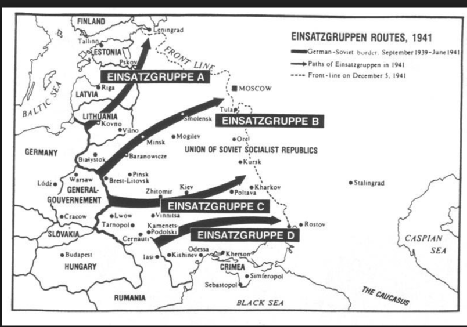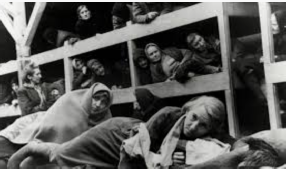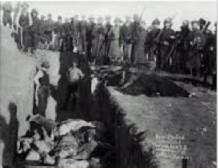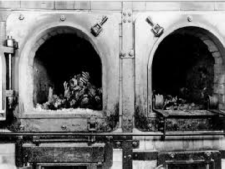|
CLICK BUTTON TO GO |
|
|
|
|
|
|
|
|
|
|
|
|
|
Videos |
|
|
|
|
|
|
|
|
|
|
|
|
|
PART 1 T O P I C |
|
|
|
|
|
|
|
|
|
|
|
|
|
|
|
|
|
|
JewishWikipedia.info
WHO WERE THE EINSATZGRUPPEN?
Holocaust Research Project (Detailed pages are attached to this link)
The Einsatzgruppen were special SS mobile formations tasked with carrying out the mass murder of Jews, communist functionaries, and others deemed unfit to live by the Nazis.
They were first seen in action in Austria and the annexed parts of Czechoslovakia in 1938, as German forces occupied all (in the case of Austria) or certain regions (in the case of Czechoslovakia) of these countries in relatively peaceful annexations to the Reich.
For the Polish campaign in 1939, Reinhard Heydrich, Chief of Reich Security, formed 6 major Einsatzgruppen der Sicherheitspolizei; five of these units were attached to the advancing German army, whilst the other unit was designated for service in the Posen (Poznan) district.
The total strength of the Einsatzgruppen during the Polish campaign, was approximately 2,700 men. Their prime role was the arrest of the politically unreliable, confiscation of weapons, police intelligence and actions against Jews.
From 1 September to 25 October 1939, over 500 towns and villages were burned and over 16,000 people were executed by the Einsatzgruppen.
Far more infamous were the Einsatzgruppen which were formed in the spring of 1941 for the campaign against Russia. Adolf Hitler issued an order that the Security Police and Security Services would assist the army in combating resistance behind the front lines.
The Einsatzgruppen commanders were carefully selected by Heydrich from the best educated and most fanatical Nazis.
The Germans formed four Einsatzgruppen.
Einsatzgruppe A – Attached to Army Group North – 990 men
Einsatzgruppe B – Attached to Army Group Centre – 665 men
Einsatzgruppe C – Attached to Army Group South - 700 men
Einsatzgruppe D – Attached to German 11th Army - 600 men

.
Map of
Einsatzgruppen Actions
Three of the four commanders held a doctorate, whilst one was a double PhD; Dr Franz Walter Stahlecker ( Einsatzgruppe A), Dr. Dr Otto Rasch ( C), Dr Otto Ohlendorf (D). Einsatzgruppe B was commanded by Artur Nebe, then head of the Criminal Police (Kripo).
The Einsatzgruppen’s general method of execution was shooting, although some gas vans were used. The victims were ordered to report to a central location, or were rounded up in organised man-hunts, often using local militia. Usually they were taken to remote spots and shot.
When conducting executions by shooting, the Germans would frequently use existing ravines, sand-pits, quarries, or abandoned Russian anti-tank ditches. If no such facility existed then the Germans would make the victims dig their own graves.
Very precise records of the Einsatzgruppen activities were maintained. The Commanders in the field were required to send regular operational reports to Heydrich in Berlin. Many of these reports have survived, and were used at War Crimes trials at Nürnberg.
Most Einsatzgruppen were disbanded as late as 1944. Einsatzgruppe D was the exception, being disbanded in July 1943, but in those few short years their combined deadly activity had claimed over seven hundred thousand lives.
The Einsatzgruppen commanders and officers were tried at Nürnberg and elsewhere. Seven were executed, including Blobel, Ohlendorf, Naumann and Schöngarth, but whilst over 50 Einsatzgruppen officers were brought to trial, the sentences they received were frequently lenient in comparison to the severity of their crimes.
EINSATZGRUPPEN
Wikipedia
OVERVIEW
Einsatzgruppen (German for "task forces", "deployment groups"; singular Einsatzgruppe; official full name Einsatzgruppen der Sicherheitspolizei und des SD) were Schutzstaffel (SS) paramilitary death squads of Nazi Germany that were responsible for mass killings, primarily by shooting, during World War II. The Einsatzgruppen were involved in the murder of much of the intelligentsia and cultural elite of Poland, and had an integral role in the implementation of the so-called "Final Solution to the Jewish question" (Die Endlösung der Judenfrage) in territories conquered by Nazi Germany. Almost all of the people they killed were civilians, beginning with the intelligentsia and swiftly progressing to Soviet political commissars, Jews, and Gypsies throughout Eastern Europe.
Under the direction of Reichsführer-SS Heinrich Himmler and the supervision of SS-Obergruppenführer Reinhard Heydrich, the Einsatzgruppen operated in territories occupied by the German armed forces following the invasion of Poland in September 1939 and Operation Barbarossa (the invasion of the Soviet Union) in June 1941. The Einsatzgruppen worked hand-in-hand with the Orpo Police Battalions on the Eastern Front to carry out operations ranging from the murder of a few people to operations which lasted over two or more days, such as the massacre at Babi Yar with 33,771 Jews killed in two days, and the Rumbula massacre (with about 25,000 killed in two days of shooting). As ordered by Nazi leader Adolf Hitler, the Wehrmacht cooperated with the Einsatzgruppen and provided logistical support for their operations. Historian Raul Hilberg estimates that between 1941 and 1945 the Einsatzgruppen and related auxiliary troops killed more than two million people, including 1.3 million Jews. The total number of Jews murdered during the Holocaust is estimated at 5.5 to 6 million people.
After the close of World War II, 24 senior leaders of the Einsatzgruppen were prosecuted in the Einsatzgruppen Trial in 1947–48, charged with crimes against humanity and war crimes. Fourteen death sentences and two life sentences were handed out. Four additional Einsatzgruppe leaders were later tried and executed by other nations.
PLANS FOR THE MIDDLE EAST AND BRITAIN
According to research by German historians Klaus-Michael Mallmann and Martin Cüppers, an Einsatzgruppe was created in 1942 to kill the half-million Jews living in the British Mandate of Palestine and the 50,000 Jews of Egypt. Einsatzgruppe Egypt, standing by in Athens, was prepared to go to Palestine once German forces arrived there.[53] SS-Obersturmbannführer Walter Rauff was to lead the unit. Given its small staff of only 24 men, Einsatzgruppe Egypt would have needed help from local residents and from the Afrika Korps to complete their assignment. Its members planned to enlist collaborators from the local population to perform the killings under German leadership. Former Iraqi prime minister Rashid Ali al-Gaylani and the Grand Mufti of Jerusalem Haj Amin al-Husseini played roles, engaging in antisemitic radio propaganda, preparing to recruit volunteers, and in raising an Arab-German Battalion that would also follow Einsatzgruppe Egypt to the Middle East. On 20 July 1942, Walther Rauff, who was responsible for the unit, was sent to Tobruk to report to Field Marshal Erwin Rommel, Commander of the Afrika Korps. However, since Rommel was 500 km away at the First Battle of El Alamein, it is unlikely that the two were able to meet. The plans for Einsatzgruppe Egypt were set aside after the Allied victory at the Second Battle of El Alamein.[Historian Jean-Christoph Caron opines that there is no evidence that Rommel knew of or would have supported Rauff's mission.
Had Operation Sea Lion, the German plan for an invasion of the United Kingdom been launched, six Einsatzgruppen were scheduled to follow the invasion force into Britain. They were provided with a list called die Sonderfahndungsliste, G.B. ("Special Search List, G.B"), known as The Black Book after the war, of 2,300 people to be immediately imprisoned by the Gestapo. The list included Churchill, members of the cabinet, prominent journalists and authors, and members of the Czechoslovak government-in-exile.
JÄGER REPORT
Page 6 of the Jäger Report shows the number of people killed by Einsatzkommando III alone in the five-month period covered by the report as 137,346.
The Einsatzgruppen kept official records of many of their massacres and provided detailed reports to their superiors. The Jäger Report, filed by Commander SS-Standartenführer Karl Jäger on 1 December 1941 to his superior, Stahlecker (head of Einsatzgruppe A), covers the activities of Einsatzkommando III in Lithuania over the five-month period from 2 July 1941 to 25 November 1941.
Jäger's report provides an almost daily running total of the liquidations of 137,346 people, the vast majority of them Jews.The report documents the exact date and place of massacres, the number of victims, and their breakdown into categories (Jews, Communists, criminals, and so on). Women were shot from the very beginning, but initially in fewer numbers than men. Children were first included in the tally starting in mid-August, when 3,207 people were murdered in Rokiškis on 15–16 August 1941.[128] For the most part the report does not give any military justification for the killings; people were killed solely because they were Jews. In total, the report lists over 100 executions in 71 different locations. Jäger wrote: "I can state today that the goal of solving the Jewish problem in Lithuania has been reached by Einsatzkommando 3. There are no more Jews in Lithuania, apart from working Jews and their families." In a February 1942 addendum to the report, Jäger increased the total number of victims to 138,272, giving a breakdown of 48,252 men, 55,556 women, and 34,464 children. Only 1,851 of the victims were non-Jewish.
Jäger escaped capture by the Allies when the war ended. He lived in Heidelberg under his own name until his report was discovered in March 1959. Arrested and charged, Jäger committed suicide on 22 June 1959 in a Hohenasperg prison while awaiting trial for his crimes.
THE "EINSATZGRUPPEN CASE"
Holocaust Research Project
The "Einsatzgruppen Case" was officially designated
United States of America vs. Otto Ohlendorf, et al. (Case No. 9).
This trial has become known as the "Einsatzgruppen Case" because all of the defendants were charged with criminal conduct arising out of their functions as members of the Einsatzgruppen.
The German term "Einsatzgruppen" may be roughly translated "Special Task Forces". Four such special units were formed in May 1941 just before the German attack on Russia, at the direction of Hitler and Heinrich Himmler, the Reich Leader SS, and Chief of the German Police.
The units were organized by Reinhardt Heydrich, Chief of the Security Police and SD (Sicherheitsdienst or Security Service) and operated under the direct control on the Reich Security Main Office (RSHA). The personnel of the Einsatzgruppen came from the SS, the SD, the Gestapo (Secret State Police), and other police units.
The prosecution alleged that the primary purpose of the Einsatzgruppen was to accompany the German Army into the occupied East and to exterminate Jews, gypsies, Soviet officials, and other elements of the civilian population regarded as "racially" inferior or "Politically undesirable". It was charged that approximately one million human beings were victims of this program.
The Einsatzgruppen Case was tried at the Palace of Justice in Nuremberg before Military Tribunal II-A. The Tribunal convened 78 times, and the trial lasted approximately eight months, 3 July 1947 to 10 April 1948 .
The indictments against the defendants were declared by Telford Taylor Brigadier General, U.S. Army, Chief of Counsel for War Crimes
COUNT ONE - CRIMES AGAINST HUMANITY
Between May 1941 and July 1943 all of the defendants herein committed crimes against humanity, as defined in Article II of Control Council Law No. 10, in that they were principals in, accessories to, ordered, abetted, took a consenting part in, were connected with plans and enterprises involving, and were members of organizations or groups connected with, atrocities and offenses, including but not limited to, persecutions on political racial, and religious grounds, murder, extermination, imprisonment, and other inhumane acts committed against civilian populations, including German nationals and nationals of other countries.
The acts, conduct, plans, and enterprises charged in paragraph I of this count were carried out as part of a systematic program of genocide, aimed at the destruction of foreign nationals and ethnic groups by murderous extermination
Beginning in May 1941, on the orders of Himmler, special task forces called "Einsatzgruppen" were formed from the personnel of the SS, the SD, the Gestapo, and other police units.
The primary purpose of these groups was to accompany the German Army into the eastern territories, and exterminate Jews gypsies, Soviet officials, and other elements of the civilian population regarded as racially "inferior" or "politically undesirable."
Initially four Einsatzgruppen were formed, each of which supervised the operation of a number of subordinate units called "Einsatzkommandos" or "Sonderkommandos."
.Some Einsatzgruppen had, in addition, other units for special purposes. Each Einsatzgruppe, together with its subordinate units consisted of about 500 to 800 persons. Einsatzgruppe A, operating mainly in the Baltic region, included Sonderkommandos la and lb and Einsatzkommandos 2 and 3. Einsatzgruppe B, operating mainly in the area towards Moscow, included Sonderkommandos 7a and 7b, Einsatzkommandos 8 and 9, and special units named Vorkommando Moscow (also known as Sonderkommando 7e) and Trupp Smolensk.
Einsatzgruppe C, operating mainly in the area towardi Kiev, included Sonderkommandos 4a and 4b and Einsatzkommandos 5 and 6. Einsatzgruppe D, operating mainly in the area of southern Russia, included Sonderkommandos 10a and 10b andEinsatzkommandos 11a, 11b, and 12.
COUNT TWO - WAR CRIMES
Between 22 June 1941 and July 1943 all of the defendants herein committed war crimes as defined in Article 11 of Control Council Law No. 10, in that they were principals in, accessories to, ordered, abetted, took a consenting part in, were connected with plans and enterprises involving, and were members of organizations or groups connected with, atrocities and offenses against persons and property constituting violations of the laws or customs of war, including, but not limited to, murder and ill- treatment of prisoners of war and civilian populations of countries and territories under the belligerent occupation of, or otherwise controlled by Germany, and wanton destruction and devastation not justified by military necessity. The particulars concerning these crimes are set forth in paragraphs 6 to 9, inclusive, of count one of this indictment and are incorporated herein by reference.
The acts and conduct of the defendants set forth in this count were committed unlawfully, willfully, and knowingly and constitute violations of international conventions, particularly of Articles 43 and 46 of the Regulations of the Hague Convention No. IV, 1907, the Prisoner-of-War Convention (Geneva, 1929), the laws and customs of war, the general principles of criminal law as derived from the criminal laws of all civilized nations, the internal penal laws of the countries in which such crimes were committed, and Article 11 of Control Council Law No.
COUNT THREE - MEMBERS IN CRIMINAL ORGANIZATIONS
All the defendants herein are charged with membership, subsequent to 1 September 1939, in organizations declared to be criminal by the International Military Tribunal and paragraph I (d) of Article 11 of Control Council Law No. 10.
(A) All the defendants were members of the Schutzstaffeln der Nationalsozialistischen Deutschen Arbeiterpartei (commonly known as the "SS").
(B) The defendants Ohlendorf, Jost, Naumann, Rasch, Six Blobel, Blume, Sandberger, Seibert, Steimle, Biberstein, Braune Haensch, Ott, Strauch, Haussmann, Klingelhoefer, Fendler, voi Radetzky, Schubert, and Graf were members of offices (Aemterl) III, VI, and VII of the Reich Security Main Office (Reichssicherheitshauptamt - RSHA) constituting the Reich Security Service of the Reich Leader SS (Reichssicherheitsdienst des Reichs fuehrer SS), commonly known as the "SD".
(C) The defendants Rasch, Schulz, Blume, Braune, Biberstein, Nosske, and Ruehl were members of Amt IV of the Reichs sicherheitshauptamt - RSHA constituting the Secret State Police (Geheime Staatspolizei), commonly known as the "Gestapo".
Wherefore, this indictment is filed with the Secretary General of the Military Tribunals and the charges herein made against the above-named defendants are hereby presented to the Military Tribunals.
DEFENDENTS PLEA
All defendants were charged on all counts. All defendants pleaded "not guilty". The tribunal found all of them guilty on all counts, except Rühl and Graf, who were found guilty only on count 3.
Shocked and sickened by the evidence which he heard,
Justice Musmanno who presided over the trial wrote:
Judgment of the Tribunal, p. 50.
One reads and reads these accounts of which here we can give only a few excerpts and yet there remains the instinct to disbelieve, to question, to doubt. There is less of a mental barrier in accepting the weirdest stories of supernatural phenomena, as for instance, water running up hill and trees with roots reaching toward the sky, than in taking at face value these narratives which go beyond the frontiers of human cruelty and savagery. Only the fact that the reports from which we have quoted came from the pens of men within the accused organizations can the human mind be assured that all this actually happened. The reports and the statements of the defendants themselves verify what otherwise would be dismissed as the product of a disordered imagination
SEVERITY ORDER
Wikipedia
The Severity Order or Reichenau Order was the name given to an order promulgated within the German Sixth Army on the Eastern Front during World War II by Field Marshal Walther von Reichenau on 10 October 1941
It said, in part:
...The most important objective of this campaign against the Jewish-Bolshevik system is the complete destruction of its sources of power and the extermination of the Asiatic influence in European civilization. ... In this eastern theatre, the soldier is not only a man fighting in accordance with the rules of the art of war, but also the ruthless standard bearer of a national conception. ... For this reason the soldier must learn fully to appreciate the necessity for the severe but just retribution that must be meted out to the subhuman species of Jewry. ...
This infamous order paved the way for mass murder of Jews. All Jews were henceforth to be treated as de facto partisans, and commanders were directed that they be either summarily shot or handed over to the Einsatzgruppen execution squads of the SS-Totenkopfverbände as the situation dictated.
Upon hearing of the Severity Order, Reichenau's superior Field Marshal Gerd von Rundstedt expressed "complete agreement" with it, and sent out a circular to all of the Army generals under his command urging them to send out their own versions of the Severity Order, which would impress upon the troops the need to exterminate Jews. During the Nuremberg trials, however, Rundstedt denied any knowledge of that order before his capture by the Allies, although he acknowledged that Reichenau's orders "may have reached my army group and probably got into the office".
When Reichenau died, and command of the Sixth Army was taken over by General Friedrich Paulus, both the Severity Order and Hitler's Commissar Order were rescinded in his command sector.
Holocaust Trial Wikipedia
The Einsatzgruppen Trials Holocaust Education & Archive Research Team
THE EINSATZGRUPPEN -
SS PARAMILITARY DEATH SQUADS



THE
INCREDIBLE
STORY OF THE JEWISH PEOPLE
EINSATZGRUPPEN
HE NAZI DEATH SQUADS -
EPISODE 1: THE GRAVES
(JUNE-AUGUST 1941)
World at War 2018 (44.26)
This first episode provides context for when, how and why the mobile death squads, or EZG,
were established.
EINSATZGRUPPEN:
THE NAZI DEATH SQUADS -
EPISODE 2: JUDENFREI
(SEPTEMBER-DECEMBER 1941)
World at War 2018 (47.07)
In December 1941, after the EZG’s intervention, Romania, Bulgaria, Hungary and the Baltic states
are declared “Judenfrei”: free of Jews.
EINSATZGRUPPEN:
THE NAZI DEATH SQUADS -
EPISODE 3: THE PYRES (1942-1943)
World at War 2018 (44.26)
Faced with the advancing Soviet troops, Nazi Germany decides to have the bodies of death camp victims dug up and burned in graves.
BABI YAR MASSACRE
RAISA DASHEKEVICH, SURVIVOR
Yad Vashem 2016 (8.42)
ON 29–30 SEPTEMBER 1941
THE BABI YAR RAVINE
ON THE OUTSKIRTS OF KIEV
IN NAZI-OCCUPIED UKRAINE.
SAW THE MASSACRE OF
NEARLY 34,000
JEWISH MEN, WOMEN, AND CHILDREN
Raisa Dashekevich who was born in 1911 and was living in Kiev during the war years recalls how after the explosions at Kreshchatik Street Jews of Kiev were summarily accused and ordered to gather close to Babi Yar ravine. Dashkevich tells how she together with her family and other Kiev Jews went to Babi Yar, how after their arrival they were robbed of their possessions and forced to strip, then driven violently to the ravine. She recalls seeing her entire family falling into the ravine after being shot and then herself laying in the ravine buried under the dead bodies with the her dead small child. Dashekevich tells how at night she managed to crawl out of the Babi Yar ravine and to reach the peasant house near the ravine. Interview conducted by the USC Shoah Foundation Institute.
THE EINSATZGRUPPEN
SAMANTHA BUTLER 2014 (4.14)
